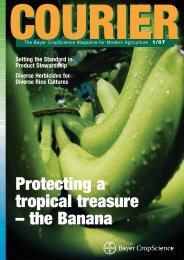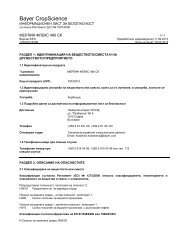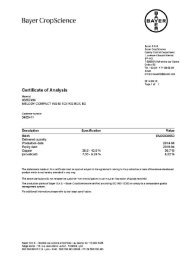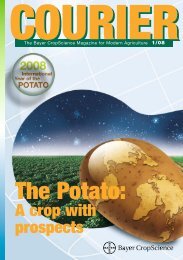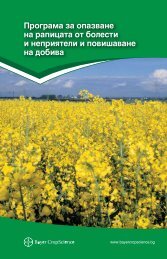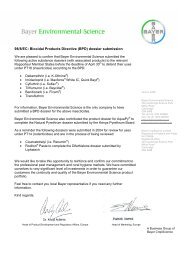For healthy potatoes - Bayer CropScience
For healthy potatoes - Bayer CropScience
For healthy potatoes - Bayer CropScience
Create successful ePaper yourself
Turn your PDF publications into a flip-book with our unique Google optimized e-Paper software.
The latent period<br />
of a pathogen<br />
A1-strains, and for the first time, the A2-<br />
mating type. These new strains quickly<br />
spread throughout Europe.<br />
Phytophthora populations deriving from<br />
the first wave of migration are referred to<br />
as „old“, whereas those from the second<br />
migration wave are referred to as “new”<br />
populations.<br />
Situation in Central Europe<br />
Time of infection<br />
Appearance of symptoms<br />
3-5 days “new” population, 4-7 days “old” population<br />
Fig. 1: The latent period is the time elapsing between infection by the<br />
fungus and the first appearance of symptoms. The latent period for the<br />
“old” population was between 5 and 7 days. The „new“ population<br />
starts to show symptoms within 3 days of an infection event.<br />
Many studies have been done to investigate<br />
the incidence of Phytophthora populations<br />
around the world. The aim has been to<br />
determine the relative preponderance and<br />
geographical distribution of the “old” and<br />
“new” populations. Gene technology<br />
methods can be used to characterize populations<br />
as being “old” or “new”.<br />
Using the polymerase chain reaction<br />
(PCR) and gel-electrophoresis, the pathogen’s<br />
mitochondrial DNA can be separated<br />
out, allowing differentiation between “old”<br />
and “new” populations. Investigations at<br />
the TU München in 2001 showed that the<br />
“old” population comprised less than 4%<br />
of the total population in Germany. The situation<br />
is similar in neighbouring countries:<br />
only a small proportion of the populations<br />
in France, Holland, Denmark and Poland is<br />
of the “old” type.<br />
The population shifts towards a “new”<br />
population have also been confirmed in<br />
North East Asia and North America.<br />
Development of<br />
„aggressive“ strains<br />
In a number of international studies, it has<br />
been possible to distinguish clearly<br />
between the “old” and “new” populations.<br />
It was found that the “new” population<br />
causes a quicker-spreading necrosis, i.e.<br />
the pathogen is able to grow more quickly<br />
through the leaf. Moreover, the “new” population<br />
shows a greater capacity for spore<br />
production, with the result that more sporangia<br />
are produced per unit area of<br />
infected leaf.<br />
14 COURIER 2/06





